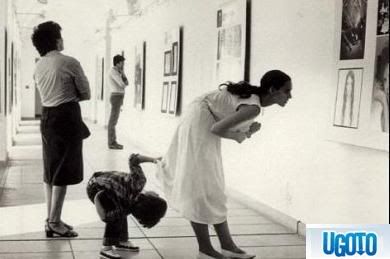 :: TOPIC ::
:: TOPIC ::How do we transform museums? By putting together unconventional exhibits and display art that goes against the norm of typical museum practices – to have a healthy dose of resonance and wonder, to educate people, to address to the general public questions that are “politically incorrect”, that forces them to think outside the box, to tell the truth when presenting historical exhibits (such as the history of colonization), to extend beyond the visual interpretation and cater to all five senses of our human existence, to question the museum as a space and use it for other (more meaningful) purposes
Who is leading these transformations? Museums in the UK and Europe, and also in Asia. Most definitely NOT in the United States (although some can allude influence given in place such as NYC, Miami and California)... mostly contemporary art museums, though I believe this can also exist in other museums. The V&A in London is a great example of this. The Venice Biennale is an eve better example, though not a museum, was amazing in adhering to all of these transformations.
How do we define transformation? Transformation in museums perpetuates when these age-old institutions stops being “a colossal mirror where man finds himself literally an object of wonder” and visitors begin to experience liminality (which, characterized by ambiguity, openness, and indeterminacy, can also be denoted as a period of transition, during which your ordinary limits to self-understanding, thought and behavior are relaxed) in the changes that are taking place.
Why are these transformations taking place? Because people like ME are sick and tired of seeing the same, boring, "Blockbuster" exhibits in museums worldwide… because art that thinks outside the box does no longer exists as a painting on the wall… because the mission of contemporary art is to act not only as a creative (or not so creative) form of human expression, but a catalyst to ask questions, to seek answers, to respond, to experiment, to instill meaning (or lack thereof) and to create a fluidity of meaning in order to exploit some kind of physical representation that links both the viewer and creator of the artwork together. On the international level, it is also accurate to state that contemporary art takes an even bigger risk not only in unconventional media, but also in subject matter that might be highly offensive to the general public (usually having to do with nudity, politics, religion, homosexuality and horrific events in history of humanity – wars, slavery, famines, genocide)… and because it makes things more interesting, as a breath of fresh air is always needed.
Are there discernible patterns in this change? There better be. It’s all a matter of time and how much money people have to re-create museums, and the response of the audience of course… as well as how many risks museums are willing to take without losing the sponsorship of their patrons.





,+encaustic+on+dibond,+each+panel+32x32+in.jpg)































 This show, which comprises of 19 works of acrylic on canvas (1o of which are in a large format -195 x 230 cm), 6 acrylic collages on paper, 8 pastel designs on paper e 3 square cross-hatched designs on paper... exhibits the work of this German contemporary artist at its very best, while one can truly grasp where he is coming from. It is no wonder that when asked about one of his watercolors, Förg responded with the following quote:
This show, which comprises of 19 works of acrylic on canvas (1o of which are in a large format -195 x 230 cm), 6 acrylic collages on paper, 8 pastel designs on paper e 3 square cross-hatched designs on paper... exhibits the work of this German contemporary artist at its very best, while one can truly grasp where he is coming from. It is no wonder that when asked about one of his watercolors, Förg responded with the following quote:






 This show was beautifully done, and gives one a sense of pride to see how contemporary artists of the present day create their work, what subject matter is more important to them and how they use art as a medium to communicate a profound message to the masses. Subjects such as poverty, racism, animal rights, music, love, sexism, murder and religion are depicted in these works, and the complilation as a whole is asethetically moving... leaving one in awe by the creation in front of them. The creation of a dialogue is also present here: what can we (as Caucasians/Italians) embrace the diversity of these artists from all over the world and incorporate the messages conveyed into our own culture and history? This is an important question to consider, especially as globalization takes place more and more here in Milan.
This show was beautifully done, and gives one a sense of pride to see how contemporary artists of the present day create their work, what subject matter is more important to them and how they use art as a medium to communicate a profound message to the masses. Subjects such as poverty, racism, animal rights, music, love, sexism, murder and religion are depicted in these works, and the complilation as a whole is asethetically moving... leaving one in awe by the creation in front of them. The creation of a dialogue is also present here: what can we (as Caucasians/Italians) embrace the diversity of these artists from all over the world and incorporate the messages conveyed into our own culture and history? This is an important question to consider, especially as globalization takes place more and more here in Milan.



